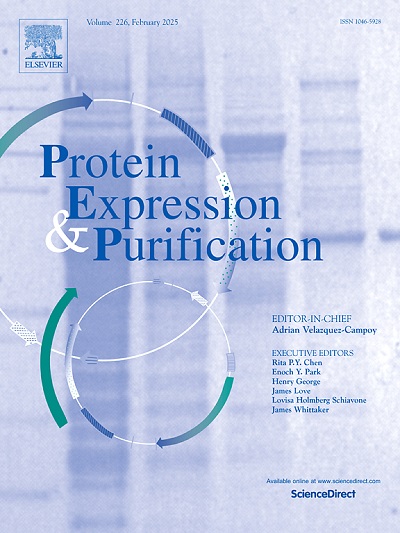Expression and biochemical characterization of a novel NAD+-dependent xylitol dehydrogenase from the plant endophytic fungus Trichoderma gamsii
IF 1.2
4区 生物学
Q4 BIOCHEMICAL RESEARCH METHODS
引用次数: 0
Abstract
Xylitol dehydrogenase (XDH; EC 1.1.1.9), encoded by the XYL2 gene, is a key enzyme in the fungal xylose metabolic pathway. In this work, a putative XDH from the plant endophytic fungus Trichoderma gamsii (TgXDH) was hetero-expressed in Escherichia coli BL21(DE3), purified to the homogeneity, and biochemically characterized. Sequence analysis revealed that TgXDH is 363 amino acids long and belongs to the zinc-containing medium-chain alcohol dehydrogenase superfamily. The size-exclusion chromatography analysis and SDS-PAGE showed that the purified recombinant TgXDH had a native molecular mass of ∼155 kDa and was composed of four identical subunits of molecular mass of ∼39 kDa. The optimum temperature and pH of this enzyme were 25 °C and pH 9.5, respectively. Kinetic analysis showed that it is an NAD+-dependent enzyme that has a polyol substrate preference (based on kcat/Km) in the order xylitol > ribitol ≈ d-sorbitol. The Km values for NAD+ with these three polyols ranged from 0.23 to 0.70 mM. Moreover, TgXDH showed high substrate affinities as compared to most of its homologs. The Km values for xylitol, ribitol, and d-sorbitol were 5.23 ± 0.68 mM, 8.01 ± 1.22 mM, and 12.34 ± 1.37 mM, respectively. Collectively, the results will contribute to understanding the biochemical properties of a novel XDH from the filamentous fungi and provide a promising XDH for industrial production of ethanol.
植物内生真菌木霉一种新型NAD+依赖性木糖醇脱氢酶的表达及生化特性研究。
木糖醇脱氢酶;EC 1.1.1.9)由XYL2基因编码,是真菌木糖代谢途径的关键酶。本研究从植物内生真菌甘姆木霉(Trichoderma gamsii, TgXDH)中分离得到一个XDH,并在大肠杆菌BL21(DE3)中进行了异源表达、纯化和生化表征。序列分析表明,TgXDH全长363个氨基酸,属于含锌中链醇脱氢酶超家族。大小不相容色谱分析和SDS-PAGE显示纯化的重组TgXDH的天然分子质量为~ 155 kDa,由四个相同的分子质量为~ 39 kDa的亚基组成。酶的最适温度为25℃,最适pH为9.5。动力学分析表明,该酶是一种NAD+依赖性酶,具有多元醇底物偏好(基于kcat/Km),其顺序为木糖醇>梨糖醇≈d-山梨醇。NAD+与这三种多元醇的Km值范围为0.23 ~ 0.70 mM。此外,TgXDH与大多数同源物相比,具有较高的底物亲和性。木糖醇、梨糖醇和d-山梨醇的Km值分别为5.23±0.68 mM、8.01±1.22 mM和12.34±1.37 mM。总的来说,这些结果将有助于了解从丝状真菌中提取的新型XDH的生化特性,并为工业生产乙醇提供有前途的XDH。
本文章由计算机程序翻译,如有差异,请以英文原文为准。
求助全文
约1分钟内获得全文
求助全文
来源期刊

Protein expression and purification
生物-生化研究方法
CiteScore
3.70
自引率
6.20%
发文量
120
审稿时长
32 days
期刊介绍:
Protein Expression and Purification is an international journal providing a forum for the dissemination of new information on protein expression, extraction, purification, characterization, and/or applications using conventional biochemical and/or modern molecular biological approaches and methods, which are of broad interest to the field. The journal does not typically publish repetitive examples of protein expression and purification involving standard, well-established, methods. However, exceptions might include studies on important and/or difficult to express and/or purify proteins and/or studies that include extensive protein characterization, which provide new, previously unpublished information.
 求助内容:
求助内容: 应助结果提醒方式:
应助结果提醒方式:


